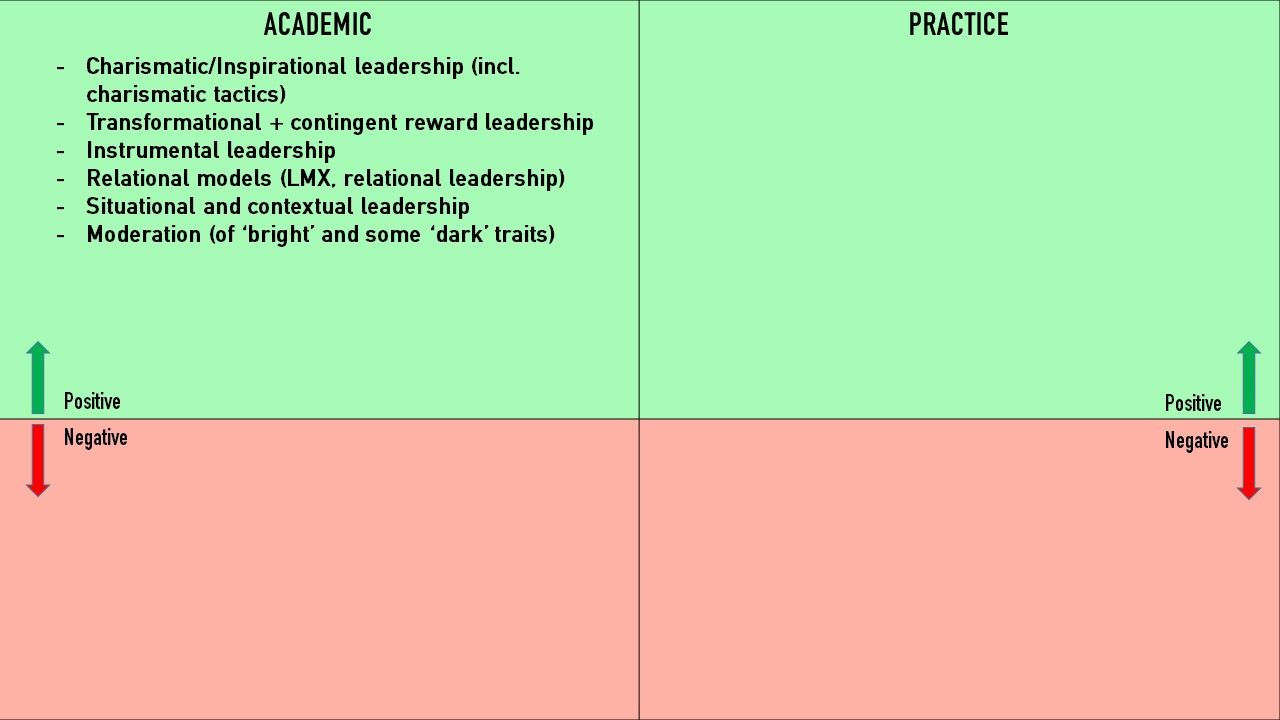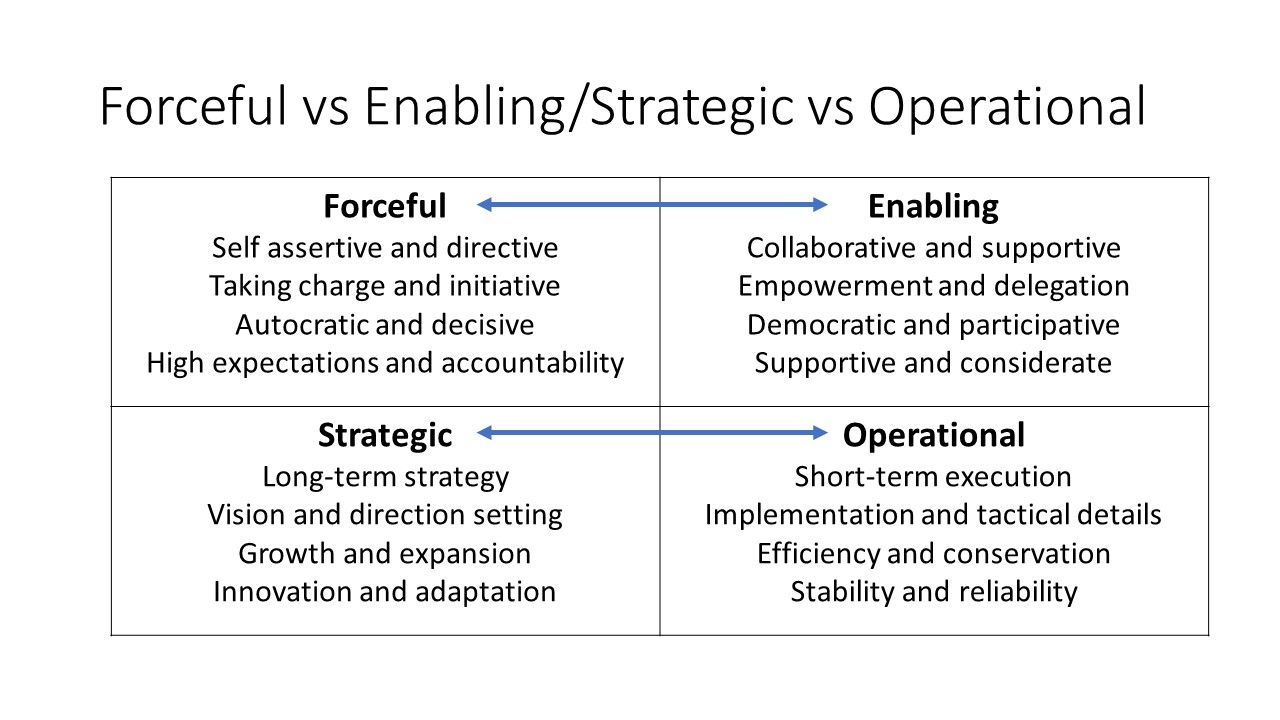My leadership philosophy - Part 6: Moderation

[This article is part of a series in which I'm sharing key lessons I've learned about what drives or derails effective leadership, distilled during my 17 year career assessing and coaching executives. Previous articles included an introduction to the series, a focus on charismatic/inspirational leadership, a summary of transformational leadership (with mention of two complimentary styles called contingent reward and instrumental leadership), a summary of tactics leaders can use to project greater charisma, a discussion of the importance of relationships to leadership, and a review of the role of situational and contextual influences on leadership.]

Introduction
The pace and rhythm of modern organizational life often does not evoke the notion of moderation. In corporate settings in particular, the maximalist pursuit of goals is common. Rare is the senior leadership team that would settle for achieving just half of their annual objectives. Furthermore, the metrics used to track the health of an enterprise seem conceptually related to extreme effort. Maximizing the profit and loss (P&L) statement seems connected to trying harder, pushing farther, exerting more focus and drive. Does any leader look at a loss on the P&L and say ‘well, more moderation in that area would help.’ Probably not. In fact the very notion of productivity suggests a high activity level. More 'doing' should lead to more results. For an example of this, look at any executive's calendar. There's nothing moderate about it.
These same structural and cultural influences may also shape our beliefs about leadership. It’s easy to assume that more planning, execution, charisma, inspiration, relationship building, communication, or commitment is 'good' - that an abundance of any of these qualities will lead to better outcomes.
And yet, among executives there is now a growing recognition of the dangers of extremity. I hear executives often use the phrase ‘taking it to the dark side’ when discussing leadership qualities, which connotes behaviours that become ineffective due to their excess. Others use language like ‘taking it too far,’ or ‘overindexing' to convey the same meaning. The other day an executive said to me that in leadership ‘you can never cross the line.’ All of these usages indicate a lesson we learned when overindulging on ice cream as kids, that you can have too much of a good thing.
These phrases suggest there’s value in moderation when it comes to leadership, and in fact, there is a growing body of (counterintuitive) evidence that supports this.
In this article, I’ll explore the paradox of how moderation enhances leadership effectiveness. I’ll outline some of the surprising research findings on the topic, suggest how moderation may strengthen leadership, and offer perspective on what ‘just the right amount’ might involve for any given leader behaviour. Finally, I’ll offer some practical suggestions on how executives can moderate their style to enhance their positive influence.
What is a curvilinear relationship?
To start our discussion of moderation, I first need to explain what a curvilinear relationship looks like in leadership research.
In the past, leadership researchers often assumed and investigated linear relationships in their work. What that means is they conducted studies premised on the notion that ‘more is better,’ or to be precise, that ‘more of a seemingly desirable thing (e.g., transformational leadership) is better, while less of a seemingly undesirable thing (e.g., passive/avoidant leadership) is also better.’


However more recently, a number of researchers uncovered findings that challenged this paradigm as they discovered curvilinear relationships in the way leadership qualities impacted outcomes.
There are different kinds of curvilinear relationships, but the one that seems to surface the most in leadership research is shaped like an inverted U (see diagram below).
What this ‘function curve’ suggests is that moderate amounts of a leadership behaviour or trait are ideal, and that extreme levels either at the low or high end of the spectrum are less effective.

In the next section, I’ll explain some findings that track with this pattern to help illustrate it further.
What's the evidence for the value of moderation?
There are now many studies which support the value of moderation in leadership. In general, these works investigate two kinds of leadership behaviours: a) those that seem desirable, and b) those that seem undesirable.
In terms of investigating seemingly desirable leadership characteristics, studies have found that moderate levels of assertiveness, charisma, empowerment, ethical leadership, intelligence, and several normal personality traits (like extraversion and conscientiousness) all lead to better leadership outcomes.
In a surprising twist, researchers have also generated several findings suggesting that leaders may want to try to express at least some minimum amount of qualities that seem at first glance undesirable.
For example, in a comprehensive study of narcissism, Emily Grijalva and colleagues found that moderate levels of narcissism contributed most to leadership effectiveness. (As a refresher, narcissism involves someone who has a grandiose sense of self-importance, requires excessive admiration, has a sense of entitlement, and lacks empathy, among other qualities.)
In a related study, Rob Kaiser and colleagues found that when trying to predict the best leadership outcomes, the optimal amount of several counterproductive personality traits (e.g., being overly bold, skeptical, passive-aggressive, or manipulative) was moderate (i.e., near the 50th percentile).
So to summarize, a growing body of research suggests that it might be adaptive for leaders to express moderate amounts of qualities that seem not only desirable and productive, but also that seem undesirable and counterproductive.
Why does moderation work for leaders?
There are several possible explanations as to why moderation might be advantageous for leaders.
Moderation facilitates leaders using complementary skills
One reason that moderation could be valuable for leaders is that it allows them to express complementary skills that contribute to effectiveness.
To illustrate, consider a leadership skill continuum developed by Kaiser and his colleagues, called Forceful vs Enabling. Forceful involves taking charge, being decisive, and pushing for results. Enabling involves empowerment, participation, and supporting people. The key idea here is that there is a tension between these two ends of the spectrum, and that expressing more of one makes it more difficult to express the other. If leaders can express both skills, this is an asset, however it’s also a great challenge.

To build out this example further, the more extreme a leader becomes in expressing forcefulness, the more difficult it may be to engage in enabling behaviours. In other words extremity, here in the form of forcefulness, ‘crowds out’ a leader’s ability to engage in the complementary or mirror-image skill.
However, if a leader's dominant style is more moderate, and resides in the middle of the spectrum midway between Forceful and Enabling, then it's more likely they’ll be able to flirt with or blend skills on both sides of the spectrum.
I should also add that Kaiser and his colleagues find that expressing complementary behaviours, while difficult and rare, contributes to leadership effectiveness. (He’s also investigated another continuum called Strategic vs Operational.)
So in summary, one reason why moderation works for leaders could be that it allows them to tap into a broader range of skills, which may apply and add positive impact to a wider range of situations (Kaiser calls this skill ‘versatility’).
Moderation ensures a healthy balance between adaptive and maladaptive behaviours
Each behaviour has adaptive and maladaptive components to it at every point along the spectrum from low to high intensity. You can think of these as 'tradeoffs' - with each behaviour, at every degree of intensity, there are 'pros' and 'cons' to it. For example extraverted leaders form relationships easily, but may struggle to listen. Conversely, introverted leaders may excel at planning and delegation, yet may not form interpersonal rapport with their team members. In another example, conscientious leaders may thrive at organizing their team’s activities, but struggle to adapt to change. Conversely, leaders who are spontaneous but careless (i.e., low in conscientiousness) may adapt to dynamic environments, yet lack time management.
Although there are tradeoffs at each point along a spectrum for a given behaviour, it could be that at extreme levels (high or low), that the ‘cons’ start to outweigh the ‘pros.’ In other words at the extremes, perhaps the ratio of adaptive vs maladaptive behaviours becomes too far tilted towards the latter. For example, at extreme levels perhaps an extraverted leader becomes so attention-seeking, dramatic and noisy that this quality overshadows their relationship building skills. Or perhaps at extreme levels of conscientiousness, a leader becomes so rigid and prone to micromanaging that these qualities dwarf any other advantages of this personality trait.
In summary, when engaging in extreme forms of a behaviour, leaders may introduce maladaptive tendencies that are so potent that they eclipse any other strengths these same qualities may offer. Moderation may help leaders preserve some meaningful adaptive quality to their behaviour.
Moderation helps leaders stay within the boundary of appropriate behaviour
Another reason leaders may benefit from moderation is that these behaviours may be viewed as more socially appropriate.
For this point I’m building on the ideas of Deanna Geddes and colleagues, in a paper in which they suggest that anger can be a productive emotion in the workplace, if it falls into a kind of middle zone. This middle zone involves sending a signal that’s strong enough in intensity so others can detect it (i.e., it crosses the lower 'Expression' threshold), but not so strong that it offends people (i.e., it stops short of the upper 'Impropriety' threshold).

This upper bound threshold of what’s considered appropriate could vary depending on the culture or norms of the organization (i.e., military vs day care), but it exists at some level.
For many leadership behaviours like assertiveness or charisma, at some extreme level people may observe the leader and say ‘that behaviour doesn’t fit or feel appropriate for this situation or environment.’
And likewise low levels of a behaviour may be unnoticeable, making them just as ineffective.
What does it mean to get leadership behaviour ‘just right’?
So if leaders should moderate their behaviour, and avoid too much or too little of a given style, what does it mean to get leadership behaviour ‘just right’? The following isn't based on research evidence, and instead emerges from my own thinking, but as far as I can tell there are at least three criteria for calibrating the ‘right amount’ of any leadership behaviour:
Intensity
Is the signal you’re sending too strong, and does it cross some threshold of appropriateness in that culture/setting? At the same time, is it strong enough for others to detect?
Frequency
Do you express this behaviour so often that the cumulative effect on others makes them feel overwhelmed or like it’s ‘too much’?
Situational fit
Does the behaviour fit the situational dynamics in which you’re using it (e.g., crisis vs steady state, formal vs informal interaction, new team vs mature team?)
Practical suggestions
Based on the preceding discussion of how moderation can benefit leaders, I’d like to make several practical suggestions for how leaders can put this knowledge to use.
Get some feedback
Gathering robust feedback from a range of stakeholders will help leaders understand the factors that trigger extreme tendencies, as well as the muted tendencies they need to amplify.
To gather feedback, consider using the Forceful vs Enabling/Strategic vs Operational framework developed by Kaiser (see below). For each quadrant, ask raters ‘what do I do too much, too little, or just right?’ As an alternative, leaders could instead ask raters what they should start doing (indicates underuse), stop doing (indicates overuse), or continue doing (indicates just right).

Consider moderating your leadership strengths
Overdoing strengths is probably more of a concern than underdoing them, as Rob Kaiser’s research shows.
This being the case, leaders may benefit from examining how they might reduce the risk of overusing their strengths.
Ask yourself, what are your biggest strengths? Which of those do you overuse? If you had to reduce the use of this strength in terms of intensity, frequency, or the range of situations in which you employ it, what would this look like?
As a secondary priority, focus on developing weaknesses
This may involve elevating or amplifying some skills by using them more frequently, or with greater intensity.
Note this goes against conventional advice to ‘just focus on and leverage your strengths’!
What are your most muted, underused tendencies, and can you express them in a stronger, more noticeable way?
Try to master opposite/complementary skills
Focus on broadening your skills to include opposites, like those mentioned in the Kaiser dimensions. See if you can convey both Forceful and Enabling as well as Strategic and Operational behaviours in your leadership repertoire. This will encourage moderation, and also flexible leadership that appeals to many situations and people.
Balance your strengths with the help of others
If you recognize that it would be difficult for you to moderate or balance your leadership style, consider hiring complementary colleagues to cover the skills sets you’re predisposed to struggle with. This will ensure these offsetting skills are represented within the team dynamic.
Remember a little bit of bad can be good (or ‘the dose makes the poison’)
As I mentioned above, some maladaptive traits in moderate amounts are… adaptive!
If at times you feel overly emotional, mistrustful, risk averse, withdrawn, confident, Machiavellian, attention-seeking, perfectionistic, or deferential, there’s nothing wrong with that. These are normal human tendencies. Rather than fret about the presence of these impulses, it’s more important to develop awareness of which of these qualities become overindexed, including in what situations, and based on which triggers. If you can keep these characteristics in the moderate zone of intensity and frequency, they may in fact help you achieve your goals.
Conclusion
In this article, I’ve explored the counterintuitive phenomenon that moderation contributes to leadership effectiveness. I've done this by describing how curvilinear relationships work, and by sharing findings indicating that moderation can enhance leader impact. In addition I’ve outlined three specific pathways through which moderation might exert it's positive effects, as well as articulated guidelines leaders can use to calibrate the ‘right amount’ of any behaviour. Finally, I’ve shared practical suggestions on how leaders can achieve moderation in their day to day repertoires.
I hope these perspectives and suggestions help you achieve a balanced, well-rounded, middle path in your leadership style.
As always I would welcome your feedback, positive or constructive, on anything you read, and I would love to learn from your perspective.
To share your perspective you can leave a comment at the end of the article, or if you prefer you can also email me your feedback at tjackson@jacksonleadership.com.
Thank you for reading. If you’d like to receive these newsletter issues direct to your inbox, please click the blue ‘Sign up now’ button below.
Tim Jackson Ph.D. is the President of Jackson Leadership, Inc. and a leadership assessment and coaching expert with 17 years of experience. He has assessed and coached leaders across a variety of sectors including agriculture, chemicals, consumer products, finance, logistics, manufacturing, media, not-for-profit, pharmaceuticals, healthcare, and utilities and power generation, including multiple private-equity-owned businesses. He's also worked with leaders across numerous functional areas, including sales, marketing, supply chain, finance, information technology, operations, sustainability, charitable, general management, health and safety, quality control, and across hierarchical levels from individual contributors to CEOs. In addition Tim has worked with leaders across several geographical regions, including Canada, the US, Western Europe, and China. He has published his ideas on leadership in both popular media, and peer-reviewed journals. Tim has a Ph.D. in organizational psychology, and is based in Toronto.
Email: tjackson@jacksonleadership.com
Web: www.jacksonleadership.com
Newsletter: www.timjacksonphd.com

Member discussion